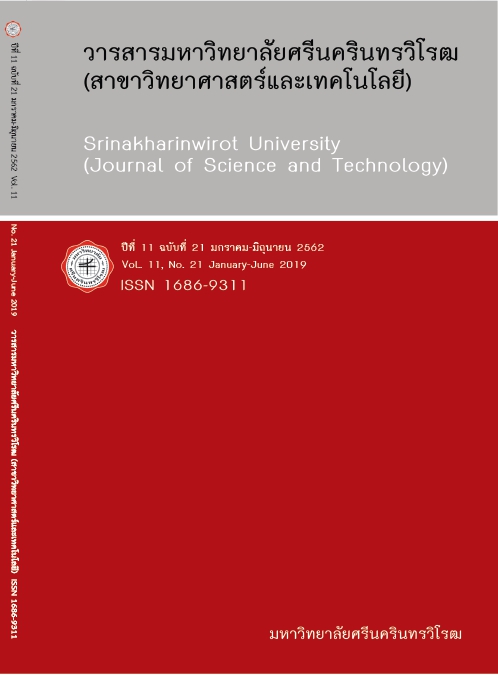ผลของโฮโดรคอลลอยด์ต่อคุณภาพของสโคนจากแป้งข้าวปลอดกลูเตน THE EFFECT OF HYDROCOLLOIDS ON THE QUALITY OF GLUTEN-FREE RICE SCONES
คำสำคัญ:
ไฮโดรคอลลอยด์, แป้งข้าว, สโคนปลอดกลูเตน, เนื้อสัมผัส, อัตราการแผ่ขยายตัวบทคัดย่อ
งานวิจัยนี้มีวัตถุประสงค์เพื่อตรวจสอบผลของไฮโดรคอลลอยด์ชนิดต่างๆ ต่อคุณภาพของสโคนจากแป้งข้าวปลอดกลูเตน ไฮโดรคอลลอยด์ทั้ง 7 ชนิด ที่เติมลงไปเป็นส่วนผสมของสโคน ได้แก่ คาร์ราจีแนน คาร์บอกซีเมทิลเซลลูโลส กัวกัม โลคัสบีนกัม เพคติน โซเดียมแอลจิเนต และแซนแทนกัม พบว่าค่าความชื้น ค่าความสว่าง (L*) และค่าความแน่นเนื้อของสโคนจากแป้งข้าวปลอดกลูเตนที่เติมไฮโดรคอลลอยด์มีแนวโน้มเพิ่มขึ้นจากตัวอย่างควบคุม (ไม่เติมไฮโดรคอลลอยด์) โดยสโคนจากแป้งข้าวปลอดกลูเตนที่เติมแซนแทนกัมและคาร์บอกซีเมทิลเซลลูโลสมีค่าความแน่นเนื้อสูงมากกว่าสองถึงสามเท่าของตัวอย่างควบคุม การเติมกัวกัมและเพกตินลงในสโคนจากแป้งข้าวปลอดกลูเตนส่งผลให้ค่าปริมาตรจำเพาะสูงกว่าตัวอย่างควบคุมอย่างมีนัยสำคัญทางสถิติ (P≤≤0.05) ในทางตรงกันข้าม การเติมแซนแทนกัมและคาร์บอกซีเมทิลเซลลูโลสส่งผลให้ค่าปริมาตรจำเพาะของสโคนจากแป้งข้าวปลอดกลูเตนต่ำกว่าตัวอย่างควบคุมอย่างมีนัยสำคัญทางสถิติ (P≤≤0.05) การเติมไฮโดรคอลลอยด์จะนำไปสู่การลดลงของอัตราการแผ่ขยายตัวของสโคนยกเว้นกรณีที่เติมคาร์ราจีแนน การทดสอบความชอบจากผู้บริโภค (N = 80) โดยวิธี 9-Point Hedonic Scale พบว่า คะแนนความชอบโดยรวมของสโคนจากแป้งข้าวปลอดกลูเตนมีค่าเพิ่มขึ้นเล็กน้อยเมื่อเติมไฮโดรคอลลอยด์ (คาร์บอกซีเมทิลเซลลูโลส โลคัสบีนกัม เพคติน และโซเดียมแอลจิเนต) โดยรวมการเติมแซนแทนกัม และคาร์บอกซีเมทิลเซลลูโลสมีผลต่อคุณภาพด้านเนื้อสัมผัสของสโคนจากแป้งข้าวปลอดกลูเตนมากกว่าไฮโดรคอลลอยด์ชนิดอื่นๆ ที่ใช้ในการศึกษานี้
Downloads
เอกสารอ้างอิง
[2] Sciarini, Lorena S.; Ribotta, Pablo D.; León, Alberto E.; & Pérez, Gabriela T. (2010, November). Effect of hydrocolloids on gluten-free batter properties and bread quality. International Journal of Food
Science and Technology. 4(11): 2306-2312.
[3] Preichardt, Leidi D.; Vendruscolo, Claire T.; Gularte, Márcia A.; & Moreira, Angelita da S. (2011, December). The role of xanthan gum in the quality of gluten free cakes: improved bakery products for celiac patients. International Journal of Food Science and Technology. 46(12): 2591-2597.
[4] Jnawali, Prakriti; Kumar, Vikas; & Tanwar, Beenu. (2016, December). Celiac disease: Overview and considerations for development of gluten-free foods. Food Science and Human Wellness. 5(4): 169-176.
[5] Rößle, Christian; Ktenioudaki, Anastasia; & Gallaghe, Eimear. (2011, June). Inulin and oligofructose as fat and sugar substitutes in quick breads (scones): a mixture design approach. European Food Research Technology. 233:167-181.
[6] Mohammadi, Mehrdad; Sadeghnia, Nasim; Azizi, Mohammad-Hossain; Neyestani, Tirang-Reza; & Mortazavian, Amir Mohammad. (2014, July). Development of gluten-free flat bread using hydrocolloids: Xanthan and CMC. Journal of Industrial and Engineering Chemistry. 20(4): 1812-1818.
[7] Houben, Andreas; Höchstötter, Agnes; & Becker, Thamas. (2012, August). Possibilities to increase the quality in gluten-free bread production: an overview. European Food Research Technology. 235(2): 195-208.
[8] Devisetti, Rajesh; Ravi, Ramasamy; & Bhattacharya, Sila. (2015, November). Effect of Hydrocolloids on Quality of Proso Millet Cookie. Food and Bioprocess Technology. 8(11): 2298-2308.
[9] Varavinit, Saiyavit; & Shobsngob, Sujin. (2000, July). Comparative properties of cakes prepared from rice flour and wheat flour. European Food Research and Technology. 211(2): 117-120.
[10] Likitwattanasade, Teerarat; Hongsprabhas,Parichat. (2010, July). Effect of storage proteins on pasting properties and microstructure of Thai rice. Food Research International. 43(5): 1402-1409.
[11] Association of Official Analytical Chemists (AOAC). (2002). Official methods of analysis. 17th ed. Washington, DC: Association of Official Analytical Chemists.
[12] American Association of Cereal Chemist (AACC). (2000). Approved Methods of the American Association of Cereal Chemist. 10th ed. St. Paul, MN, USA: American Association of Cereal Chemist.
[13] Francis, Frederic J.; & Clydesdale, Fergus M. (1975). Food Colorimetry: Theory and Applications.Westport, Connecticut: The Avi Publishing Co., Inc.
[14] Kaur, Maninder; Sandhu, Kawaljit Singh; Arora, AmitPal; & Sharma, Aruna. (2015, June). Gluten free biscuits prepared from buckwheat flour by incorporation of various gums: Physicochemical and sensory properties. LWT-Food Science and Technology. 62(1): 628-632.
[15] Kohajdová, Zlatica; & Karovičová, Jolana. (2009, February). Application of hydrocolloids as baking improvers. Chemical Papers. 63(1): 26-38.
[16] Gómez, Manuel; Ronda, Felicidad; Coballera, Pedro A.; Blanco, Carlos A.; & Rosell, Cristina M. (2007, March). Functionality of different hydrocolloids on the quality and shelf-life of yellow layer cakes. Food Hydrocolloids. 21(2): 167-173.
[17] Rosell, Cristima M.; Rojas, Jose A.; & Barber, Benedito de. (2001, January). Influence of hydrocolloids on dough rheology and bread quality. Food Hydrocolloids. 15(1): 75-81.
[18] Lazaridou, Athina; Duta, Denisa; Papageorgiou, Maria; Belc, Nastasia; & Biliaderis, Costas. (2007, April). Effects of hydrocolloids on dough rheology and bread quality parameters in gluten free formulations. Journal of Food Engineering. 79(3): 1033-1047.
[19] Mezaize, Sandra; Chevallier, Sylvie; Le-Bail, Alain; & de-Lamballerie, Marie. (2009, April). Optimizationof gluten free formulations for french-style breads. Journal of Food Science. 74(3): 140-146.
[20] Bodart, Magali; de Peñaranda, Rodrigue; Deneyer, Arnaud; & Flamant, Gilles. (2008, December). Photometry and colorimetry characterization of materials in daylighting evaluation tools. Building and Environment. 43(12): 2046-2058.
ดาวน์โหลด
เผยแพร่แล้ว
รูปแบบการอ้างอิง
ฉบับ
ประเภทบทความ
สัญญาอนุญาต
วารสารมหาวิทยาลัยศรีนครินทรวิโรฒ สาขาวิทยาศาสตร์และเทคโนโลยี อยู่ภายใต้การอนุญาต Creative Commons Attribution-NonCommercial-NoDerivs 4.0 International (CC-BY-NC-ND 4.0) เว้นแต่จะระบุไว้เป็นอย่างอื่น โปรดอ่านหน้านโยบายของวารสารสำหรับข้อมูลเพิ่มเติมเกี่ยวกับการเข้าถึงแบบเปิด ลิขสิทธิ์ และการอนุญาต



